4.4: Multiplication of Fractions
- Page ID
- 48853
\( \newcommand{\vecs}[1]{\overset { \scriptstyle \rightharpoonup} {\mathbf{#1}} } \)
\( \newcommand{\vecd}[1]{\overset{-\!-\!\rightharpoonup}{\vphantom{a}\smash {#1}}} \)
\( \newcommand{\id}{\mathrm{id}}\) \( \newcommand{\Span}{\mathrm{span}}\)
( \newcommand{\kernel}{\mathrm{null}\,}\) \( \newcommand{\range}{\mathrm{range}\,}\)
\( \newcommand{\RealPart}{\mathrm{Re}}\) \( \newcommand{\ImaginaryPart}{\mathrm{Im}}\)
\( \newcommand{\Argument}{\mathrm{Arg}}\) \( \newcommand{\norm}[1]{\| #1 \|}\)
\( \newcommand{\inner}[2]{\langle #1, #2 \rangle}\)
\( \newcommand{\Span}{\mathrm{span}}\)
\( \newcommand{\id}{\mathrm{id}}\)
\( \newcommand{\Span}{\mathrm{span}}\)
\( \newcommand{\kernel}{\mathrm{null}\,}\)
\( \newcommand{\range}{\mathrm{range}\,}\)
\( \newcommand{\RealPart}{\mathrm{Re}}\)
\( \newcommand{\ImaginaryPart}{\mathrm{Im}}\)
\( \newcommand{\Argument}{\mathrm{Arg}}\)
\( \newcommand{\norm}[1]{\| #1 \|}\)
\( \newcommand{\inner}[2]{\langle #1, #2 \rangle}\)
\( \newcommand{\Span}{\mathrm{span}}\) \( \newcommand{\AA}{\unicode[.8,0]{x212B}}\)
\( \newcommand{\vectorA}[1]{\vec{#1}} % arrow\)
\( \newcommand{\vectorAt}[1]{\vec{\text{#1}}} % arrow\)
\( \newcommand{\vectorB}[1]{\overset { \scriptstyle \rightharpoonup} {\mathbf{#1}} } \)
\( \newcommand{\vectorC}[1]{\textbf{#1}} \)
\( \newcommand{\vectorD}[1]{\overrightarrow{#1}} \)
\( \newcommand{\vectorDt}[1]{\overrightarrow{\text{#1}}} \)
\( \newcommand{\vectE}[1]{\overset{-\!-\!\rightharpoonup}{\vphantom{a}\smash{\mathbf {#1}}}} \)
\( \newcommand{\vecs}[1]{\overset { \scriptstyle \rightharpoonup} {\mathbf{#1}} } \)
\( \newcommand{\vecd}[1]{\overset{-\!-\!\rightharpoonup}{\vphantom{a}\smash {#1}}} \)
\(\newcommand{\avec}{\mathbf a}\) \(\newcommand{\bvec}{\mathbf b}\) \(\newcommand{\cvec}{\mathbf c}\) \(\newcommand{\dvec}{\mathbf d}\) \(\newcommand{\dtil}{\widetilde{\mathbf d}}\) \(\newcommand{\evec}{\mathbf e}\) \(\newcommand{\fvec}{\mathbf f}\) \(\newcommand{\nvec}{\mathbf n}\) \(\newcommand{\pvec}{\mathbf p}\) \(\newcommand{\qvec}{\mathbf q}\) \(\newcommand{\svec}{\mathbf s}\) \(\newcommand{\tvec}{\mathbf t}\) \(\newcommand{\uvec}{\mathbf u}\) \(\newcommand{\vvec}{\mathbf v}\) \(\newcommand{\wvec}{\mathbf w}\) \(\newcommand{\xvec}{\mathbf x}\) \(\newcommand{\yvec}{\mathbf y}\) \(\newcommand{\zvec}{\mathbf z}\) \(\newcommand{\rvec}{\mathbf r}\) \(\newcommand{\mvec}{\mathbf m}\) \(\newcommand{\zerovec}{\mathbf 0}\) \(\newcommand{\onevec}{\mathbf 1}\) \(\newcommand{\real}{\mathbb R}\) \(\newcommand{\twovec}[2]{\left[\begin{array}{r}#1 \\ #2 \end{array}\right]}\) \(\newcommand{\ctwovec}[2]{\left[\begin{array}{c}#1 \\ #2 \end{array}\right]}\) \(\newcommand{\threevec}[3]{\left[\begin{array}{r}#1 \\ #2 \\ #3 \end{array}\right]}\) \(\newcommand{\cthreevec}[3]{\left[\begin{array}{c}#1 \\ #2 \\ #3 \end{array}\right]}\) \(\newcommand{\fourvec}[4]{\left[\begin{array}{r}#1 \\ #2 \\ #3 \\ #4 \end{array}\right]}\) \(\newcommand{\cfourvec}[4]{\left[\begin{array}{c}#1 \\ #2 \\ #3 \\ #4 \end{array}\right]}\) \(\newcommand{\fivevec}[5]{\left[\begin{array}{r}#1 \\ #2 \\ #3 \\ #4 \\ #5 \\ \end{array}\right]}\) \(\newcommand{\cfivevec}[5]{\left[\begin{array}{c}#1 \\ #2 \\ #3 \\ #4 \\ #5 \\ \end{array}\right]}\) \(\newcommand{\mattwo}[4]{\left[\begin{array}{rr}#1 \amp #2 \\ #3 \amp #4 \\ \end{array}\right]}\) \(\newcommand{\laspan}[1]{\text{Span}\{#1\}}\) \(\newcommand{\bcal}{\cal B}\) \(\newcommand{\ccal}{\cal C}\) \(\newcommand{\scal}{\cal S}\) \(\newcommand{\wcal}{\cal W}\) \(\newcommand{\ecal}{\cal E}\) \(\newcommand{\coords}[2]{\left\{#1\right\}_{#2}}\) \(\newcommand{\gray}[1]{\color{gray}{#1}}\) \(\newcommand{\lgray}[1]{\color{lightgray}{#1}}\) \(\newcommand{\rank}{\operatorname{rank}}\) \(\newcommand{\row}{\text{Row}}\) \(\newcommand{\col}{\text{Col}}\) \(\renewcommand{\row}{\text{Row}}\) \(\newcommand{\nul}{\text{Nul}}\) \(\newcommand{\var}{\text{Var}}\) \(\newcommand{\corr}{\text{corr}}\) \(\newcommand{\len}[1]{\left|#1\right|}\) \(\newcommand{\bbar}{\overline{\bvec}}\) \(\newcommand{\bhat}{\widehat{\bvec}}\) \(\newcommand{\bperp}{\bvec^\perp}\) \(\newcommand{\xhat}{\widehat{\xvec}}\) \(\newcommand{\vhat}{\widehat{\vvec}}\) \(\newcommand{\uhat}{\widehat{\uvec}}\) \(\newcommand{\what}{\widehat{\wvec}}\) \(\newcommand{\Sighat}{\widehat{\Sigma}}\) \(\newcommand{\lt}{<}\) \(\newcommand{\gt}{>}\) \(\newcommand{\amp}{&}\) \(\definecolor{fillinmathshade}{gray}{0.9}\)- understand the concept of multiplication of fractions
- be able to multiply one fraction by another
- be able to multiply mixed numbers
- be able to find powers and roots of various fractions
Fractions of Fractions
We know that a fraction represents a part of a whole quantity. For example, two fifths of one unit can be represented by

\(\dfrac{2}{5}\) of the whole is shaded.
A natural question is, what is a fractional part of a fractional quantity, or, what is a fraction of a fraction? For example, what \(\dfrac{2}{3}\) of \(\dfrac{1}{2}\)?
We can suggest an answer to this question by using a picture to examine \(\dfrac{2}{3}\) of \(\dfrac{1}{2}\).
First, let's represent \(\dfrac{1}{2}\).

\(\dfrac{1}{2}\) of the whole is shaded.
Then divide each of the\(\dfrac{1}{2}\) parts into 3 equal parts.
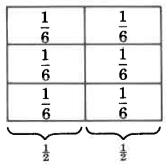
Each part is \(\dfrac{1}{6}\) of the whole.
Now we'll take \(\dfrac{2}{3}\) of the \(\dfrac{1}{2}\) unit.
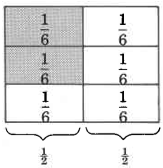
\(\dfrac{2}{3}\) of \(\dfrac{1}{2}\) is \(\dfrac{2}{6}\), which reduces to \(\dfrac{1}{3}\).
Multiplication of Fractions
Now we ask, what arithmetic operation \((+, - , \times , \div)\) will produce \(\dfrac{2}{6}\) from \(\dfrac{2}{3}\) of \(\dfrac{1}{2}\)?
Notice that, if in the fractions \(\dfrac{2}{3}\) and \(\dfrac{1}{2}\), we multiply the numerators together and the denominators together, we get precisely \(\dfrac{2}{6}\).
\(\dfrac{2 \cdot 1}{3 \cdot 2} = \dfrac{2}{6}\)
This reduces to \(\dfrac{1}{3}\) as before.
Using this observation, we can suggest the following:
The word "of" translates to the arithmetic operation "times."
To multiply two or more fractions, multiply the numerators together and then multiply the denominators together. Reduce if necessary.
\(\dfrac{\text{numerator 1}}{\text{denominator 1}} \cdot \dfrac{\text{numerator 2}}{\text{denominator 2}} = \dfrac{\text{numerator 1}}{\text{denominator 1}} \cdot \dfrac{\text{numerator 2}}{\text{denominator 2}}\)
Perform the following multiplications.
\(\dfrac{3}{4} \cdot \dfrac{1}{6} = \dfrac{3 \cdot 1}{4 \cdot 6} = \dfrac{3}{24}\) Now, reduce,
\(= \dfrac{\begin{array} {c} {^1} \\ {\cancel{3}} \end{array}}{\begin{array} {c} {\cancel{24}} \\ {^{8}} \end{array}} = \dfrac{1}{8}\)
Thus
\(\dfrac{3}{4} \cdot \dfrac{1}{6} = \dfrac{1}{8}\)
This means that \(\dfrac{3}{4}\) of \(\dfrac{1}{6}\) is \(\dfrac{1}{8}\), that is, \(\dfrac{3}{4}\) of \(\dfrac{1}{6}\) of a unit is \(\dfrac{1}{8}\) of the original unit.
\(\dfrac{3}{8} \cdot 4\). Write 4 as a fraction by writing \(\dfrac{4}{1}\)
\(\dfrac{3}{8} \cdot \dfrac{4}{1} = \dfrac{3 \cdot 4}{8 \cdot 1} = \dfrac{12}{8} = \dfrac{\begin{array} {c} {^3} \\ {\cancel{12}} \end{array}}{\begin{array} {c} {\cancel{8}} \\ {^2} \end{array}} = \dfrac{3}{2}\)
\(\dfrac{3}{8} \cdot 4 = \dfrac{3}{2}\)
This means that \(\dfrac{3}{8}\) of 4 whole units is \(\dfrac{3}{2}\) of one whole unit.
\(\dfrac{2}{5} \cdot \dfrac{5}{8} \cdot \dfrac{1}{4} = \dfrac{2 \cdot 5 \cdot 1}{5 \cdot 8 \cdot 4} = \dfrac{\begin{array} {c} {^1} \\ {\cancel{10}} \end{array}}{\begin{array} {c} {\cancel{160}} \\ {^{16}} \end{array}} = \dfrac{1}{16}\)
This means that \(\dfrac{2}{5}\) of \(\dfrac{5}{8}\) of \(\dfrac{1}{4}\) of a whole unit is \(\dfrac{1}{16}\) of the original unit.
Practice Set A
Perform the following multiplications.
\(\dfrac{2}{5} \cdot \dfrac{1}{6}\)
- Answer
-
\(\dfrac{1}{15}\)
Practice Set A
\(\dfrac{1}{4} \cdot \dfrac{8}{9}\)
- Answer
-
\(\dfrac{2}{9}\)
Practice Set A
\(\dfrac{4}{9} \cdot \dfrac{15}{16}\)
- Answer
-
\(\dfrac{5}{12}\)
Practice Set A
\((\dfrac{2}{3}) (\dfrac{2}{3})\)
- Answer
-
\(\dfrac{4}{9}\)
Practice Set A
\((\dfrac{7}{4}) (\dfrac{8}{5})\)
- Answer
-
\(\dfrac{14}{5}\)
Practice Set A
\(\dfrac{5}{6} \cdot \dfrac{7}{8}\)
- Answer
-
\(\dfrac{35}{48}\)
Practice Set A
\(\dfrac{2}{3} \cdot 5\)
- Answer
-
\(\dfrac{10}{3}\)
Practice Set A
\((\dfrac{3}{10}) (10)\)
- Answer
-
\(\dfrac{15}{2}\)
Practice Set A
\(\dfrac{3}{4} \cdot \dfrac{8}{9} \cdot \dfrac{5}{12}\)
- Answer
-
\(\dfrac{5}{18}\)
Multiplying Fractions by Dividing Out Common Factors
We have seen that to multiply two fractions together, we multiply numerators together, then denominators together, then reduce to lowest terms, if necessary. The reduction can be tedious if the numbers in the fractions are large. For example,
\(\dfrac{9}{16} \cdot \dfrac{10}{21} = \dfrac{9 \cdot 10}{16 \cdot 21} = \dfrac{90}{336} = \dfrac{45}{168} = \dfrac{15}{28}\)
We avoid the process of reducing if we divide out common factors before we multiply.
\(\dfrac{9}{16} \cdot \dfrac{10}{21} = \dfrac{\begin{array} {c} {^3} \\ {\cancel{9}} \end{array}}{\begin{array} {c} {\cancel{16}} \\ {^8} \end{array}} \cdot \dfrac{\begin{array} {c} {^5} \\ {\cancel{10}} \end{array}}{\begin{array} {c} {\cancel{21}} \\ {^7} \end{array}} = \dfrac{3 \cdot 5}{8 \cdot 7} = \dfrac{15}{56}\)
Divide 3 into 9 and 21, and divide 2 into 10 and 16. The product is a fraction that is reduced to lowest terms.
To multiply fractions by dividing out common factors, divide out factors that are common to both a numerator and a denominator. The factor being divided out can appear in any numerator and any denominator.
Perform the following multiplications.
\(\dfrac{4}{5} \cdot \dfrac{5}{6}\)
\(\dfrac{\begin{array} {c} {^2} \\ {\cancel{4}} \end{array}}{\begin{array} {c} {\cancel{5}} \\ {^1} \end{array}} \cdot \dfrac{\begin{array} {c} {^1} \\ {\cancel{5}} \end{array}}{\begin{array} {c} {\cancel{6}} \\ {^1} \end{array}} = \dfrac{2 \cdot 1}{1 \cdot 3} = \dfrac{2}{3}\)
Divide 4 and 6 by 2
Divide 5 and 5 by 5
\(\dfrac{8}{12} \cdot \dfrac{8}{10}\)
\(\dfrac{\begin{array} {c} {^4} \\ {\cancel{8}} \end{array}}{\begin{array} {c} {\cancel{12}} \\ {^3} \end{array}} \cdot \dfrac{\begin{array} {c} {^2} \\ {\cancel{8}} \end{array}}{\begin{array} {c} {\cancel{10}} \\ {^5} \end{array}} = \dfrac{4 \cdot 2}{3 \cdot 5} = \dfrac{8}{15}\)
Divide 8 and 10 by 2.
Divide 8 and 12 by 4.
\(8 \cdot \dfrac{5}{12} = \dfrac{\begin{array} {c} {^2} \\ {\cancel{8}} \end{array}}{1} \cdot \dfrac{5}{\begin{array} {c} {\cancel{12}} \\ {^3} \end{array}} = \dfrac{2 \cdot 5}{1 \cdot 3} = \dfrac{10}{3}\)
\(\dfrac{35}{18} \cdot \dfrac{63}{105}\)
\(\dfrac{\begin{array} {c} {^{^1}} \\ {^{\cancel{7}}} \\ {\cancel{35}} \end{array}}{\begin{array} {c} {\cancel{18}} \\ {^2} \end{array}} \dfrac{\begin{array} {c} {^7} \\ {\cancel{63}} \end{array}}{\begin{array} {c} {\cancel{105}} \\ {^{\cancel{21}}} \\ {^{^3}} \end{array}} = \dfrac{1 \cdot 7}{2 \cdot 3} = \dfrac{7}{6}\)
\(\dfrac{13}{9} \cdot \dfrac{6}{39} \cdot \dfrac{1}{12}\)
\(\dfrac{\begin{array} {c} {^1} \\ {\cancel{13}} \end{array}}{9} \cdot \dfrac{\begin{array} {c} {^{^1}} \\ {^{\cancel{2}}} \\ {\cancel{6}} \end{array}}{\begin{array} {c} {\cancel{39}} \\ {^{\cancel{3}}} \\ {^{^1}} \end{array}} \cdot \dfrac{1}{\begin{array} {c} {\cancel{12}} \\ {^6} \end{array}} = \dfrac{1 \cdot 1 \cdot 1}{9 \cdot 1 \cdot 6} = \dfrac{1}{54}\)
Practice Set B
Perform the following multiplications.
\(\dfrac{2}{3} \cdot \dfrac{7}{8}\)
- Answer
-
\(\dfrac{7}{12}\)
Practice Set B
\(\dfrac{25}{12} \cdot \dfrac{10}{45}\)
- Answer
-
\(\dfrac{25}{54}\)
Practice Set B
\(\dfrac{40}{48} \cdot \dfrac{72}{90}\)
- Answer
-
\(\dfrac{2}{3}\)
Practice Set B
\(7 \cdot \dfrac{2}{49}\)
- Answer
-
\(\dfrac{2}{7}\)
Practice Set B
\(12 \cdot \dfrac{3}{8}\)
- Answer
-
\(\dfrac{9}{2}\)
Practice Set B
\((\dfrac{13}{7}) (\dfrac{14}{26})\)
- Answer
-
1
Practice Set B
\(\dfrac{16}{10} \cdot \dfrac{22}{6} \cdot \dfrac{21}{44}\)
- Answer
-
\(\dfrac{14}{5}\)
Multiplication of Mixed Numbers
Multiplying Mixed Numbers
To perform a multiplication in which there are mixed numbers, it is convenient to first convert each mixed number to an improper fraction, then multiply.
Perform the following multiplications. Convert improper fractions to mixed numbers.
\(1 \dfrac{1}{8} \cdot 4 \dfrac{2}{3}\)
Convert each mixed number to an improper fraction.
\(1 \dfrac{1}{8} = \dfrac{8 \cdot 1 + 1}{8} = \dfrac{9}{8}\)
\(4 \dfrac{2}{3} = \dfrac{4 \cdot 3 + 2}{3} = \dfrac{14}{3}\)
\(\dfrac{\begin{array} {c} {^3} \\ {\cancel{9}} \end{array}}{\begin{array} {c} {\cancel{8}} \\ {^4} \end{array}} \cdot \dfrac{\begin{array} {c} {^7} \\ {\cancel{14}} \end{array}}{\begin{array} {c} {\cancel{3}} \\ {^1} \end{array}} = \dfrac{3 \cdot 7}{4 \cdot 1} = \dfrac{21}{4} = 5 \dfrac{1}{4}\)
\(16 \cdot 8 \dfrac{1}{5}\)
Convert \(8 \dfrac{1}{5}\) to an improper fraction.
\(8 \dfrac{1}{5} = \dfrac{5 \cdot 8 + 1}{5} = \dfrac{41}{5}\)
\(\dfrac{16}{1} \cdot \dfrac{41}{5}\).
There are no common factors to divide out.
\(\dfrac{16}{1} \cdot \dfrac{41}{5} = \dfrac{16 \cdot 41}{1 \cdot 5} = \dfrac{656}{5} = 131 \dfrac{1}{5}\)
\(9 \dfrac{1}{6} \cdot 12 \dfrac{3}{5}\)
Convert to improper fractions.
\(9 \dfrac{1}{6} = \dfrac{6 \cdot 9 + 1}{6} = \dfrac{55}{6}\)
\(12 \dfrac{3}{5} = \dfrac{5 \cdot 12 + 3}{5} = \dfrac{63}{5}\)
\(\dfrac{\begin{array} {c} {^{11}} \\ {\cancel{55}} \end{array}}{\begin{array} {c} {\cancel{6}} \\ {^2} \end{array}} \cdot \dfrac{\begin{array} {c} {^{21}} \\ {\cancel{63}} \end{array}}{\begin{array} {c} {\cancel{5}} \\ {^1} \end{array}} = \dfrac{11 \cdot 21}{2 \cdot 1} = \dfrac{231}{2} = 115 \dfrac{1}{2}\)
\(\begin{array} {rcl} {\dfrac{11}{8} \cdot 4 \dfrac{1}{2} \cdot 3 \dfrac{1}{8}} & = & {\dfrac{11}{8} \cdot \dfrac{\begin{array} {c} {^3} \\ {\cancel{9}} \end{array}}{\begin{array} {c} {\cancel{2}} \\ {^1} \end{array}} \cdot \dfrac{\begin{array} {c} {^5} \\ {\cancel{10}} \end{array}}{\begin{array} {c} {\cancel{3}} \\ {^1} \end{array}}} \\ {} & = & {\dfrac{11 \cdot 3 \cdot 5}{8 \cdot 1 \cdot 1} = \dfrac{165}{8} = 20 \dfrac{5}{8}} \end{array}\)
Practice Set C
Perform the following multiplications. Convert improper fractions to mixed numbers.
\(2 \dfrac{2}{3} \cdot 2 \dfrac{1}{4}\)
- Answer
-
6
Practice Set C
\(6 \dfrac{2}{3} \cdot 3 \dfrac{3}{10}\)
- Answer
-
22
Practice Set C
\(7 \dfrac{1}{8} \cdot 12\)
- Answer
-
\(85\dfrac{1}{2}\)
Practice Set C
\(2 \dfrac{2}{5} \cdot 3 \dfrac{3}{4} \cdot 3 \dfrac{1}{3}\)
- Answer
-
30
Powers and Roots of Fractions
Find the value of each of the following.
\((\dfrac{1}{6})^2 = \dfrac{1}{6} \cdot \dfrac{1}{6} = \dfrac{1 \cdot 1}{6 \cdot 6} = \dfrac{1}{36}\)
\(\sqrt{\dfrac{9}{100}}\). We’re looking for a number, call it ?, such that when it is squared, \(\dfrac{9}{100}\) is produced.
\((?)^2 = \dfrac{9}{100}\)
We know that
\(3^2 = 9\) and \(10^2 = 100\)
We'll try \(\dfrac{3}{10}\). Since
\((\dfrac{3}{10})^2 = \dfrac{3}{10} \cdot \dfrac{3}{10} = \dfrac{3 \cdot 3}{10 \cdot 10} = \dfrac{9}{100}\)
\(\sqrt{\dfrac{9}{100}} = \dfrac{3}{10}\)
\(4\dfrac{2}{5} \cdot \sqrt{\dfrac{100}{121}}\)
\(\dfrac{\begin{array} {c} {^2} \\ {\cancel{22}} \end{array}}{\begin{array} {c} {\cancel{5}} \\ {^1} \end{array}} \cdot \dfrac{^2}{\cancel{10}} = \dfrac{\begin{array} {c} {\cancel{11}} \\ {^1} \end{array}}{\begin{array} {c} {} \\ {} \end{array}} = \dfrac{4}{1} = 4\)
\(4 \dfrac{2}{5} \cdot \sqrt{\dfrac{100}{121}} = 4\)
Practice Set D
Find the value of each of the following.
\((\dfrac{1}{8})^2\)
- Answer
-
\(\dfrac{1}{64}\)
Practice Set D
\((\dfrac{3}{10})^2\)
- Answer
-
\(\dfrac{9}{100}\)
Practice Set D
\(\sqrt{\dfrac{4}{9}}\)
- Answer
-
\(\dfrac{2}{3}\)
Practice Set D
\(\sqrt{\dfrac{1}{4}}\)
- Answer
-
\(\dfrac{1}{2}\)
Practice Set D
\(\dfrac{3}{8} \cdot \sqrt{\dfrac{1}{9}}\)
- Answer
-
\(\dfrac{1}{8}\)
Practice Set D
\(9 \dfrac{1}{3} \cdot \sqrt{\dfrac{81}{100}}\)
- Answer
-
\(8 \dfrac{2}{5}\)
Practice Set D
\(2 \dfrac{8}{13} \cdot \sqrt{\dfrac{169}{16}}\)
- Answer
-
\(8 \dfrac{1}{2}\)
Exercises
For the following six problems, use the diagrams to find each of the following parts. Use multiplication to verify your result.
Exercise \(\PageIndex{1}\)
\(\dfrac{3}{4}\) of \(\dfrac{1}{3}\)
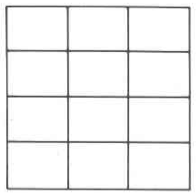
- Answer
-
\(\dfrac{1}{4}\)
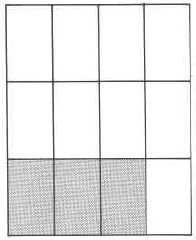
Exercise \(\PageIndex{2}\)
\(\dfrac{2}{3}\) of \(\dfrac{3}{5}\)
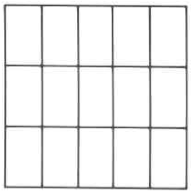
Exercise \(\PageIndex{3}\)
\(\dfrac{2}{7}\) of \(\dfrac{7}{8}\)
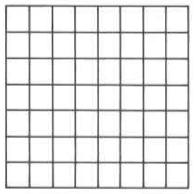
- Answer
-
\(\dfrac{1}{4}\)
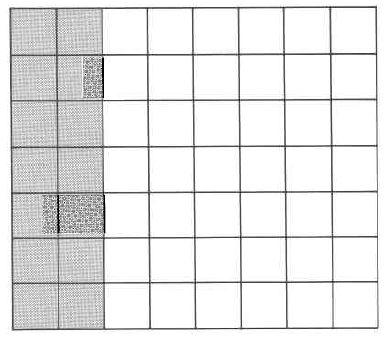
Exercise \(\PageIndex{4}\)
\(\dfrac{5}{6}\) of \(\dfrac{3}{4}\)
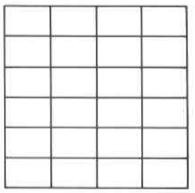
Exercise \(\PageIndex{5}\)
\(\dfrac{1}{8}\) of \(\dfrac{1}{8}\)
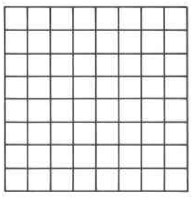
- Answer
-
\(\dfrac{1}{64}\)
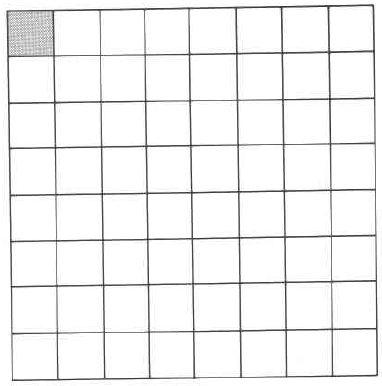
Exercise \(\PageIndex{6}\)
\(\dfrac{7}{12}\) of \(\dfrac{6}{7}\)
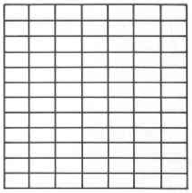
For the following problems, find each part without using a diagram.
Exercise \(\PageIndex{7}\)
\(\dfrac{1}{2}\) of \(\dfrac{4}{5}\)
- Answer
-
\(\dfrac{2}{5}\)
Exercise \(\PageIndex{8}\)
\(\dfrac{3}{5}\) of \(\dfrac{5}{12}\)
Exercise \(\PageIndex{9}\)
\(\dfrac{1}{4}\) of \(\dfrac{8}{9}\)
- Answer
-
\(\dfrac{2}{9}\)
Exercise \(\PageIndex{10}\)
\(\dfrac{3}{16}\) of \(\dfrac{12}{15}\)
Exercise \(\PageIndex{11}\)
\(\dfrac{2}{9}\) of \(\dfrac{6}{5}\)
- Answer
-
\(\dfrac{4}{15}\)
Exercise \(\PageIndex{12}\)
\(\dfrac{1}{8}\) of \(\dfrac{3}{8}\)
Exercise \(\PageIndex{13}\)
\(\dfrac{2}{3}\) of \(\dfrac{9}{10}\)
- Answer
-
\(\dfrac{3}{5}\)
Exercise \(\PageIndex{14}\)
\(\dfrac{18}{19}\) of \(\dfrac{38}{54}\)
Exercise \(\PageIndex{15}\)
\(\dfrac{5}{6}\) of \(2 \dfrac{2}{5}\)
- Answer
-
2
Exercise \(\PageIndex{16}\)
\(\dfrac{3}{4}\) of \(3 \dfrac{3}{5}\)
Exercise \(\PageIndex{17}\)
\(\dfrac{3}{2}\) of \(2 \dfrac{2}{9}\)
- Answer
-
\(\dfrac{10}{3}\) or \(3 \dfrac{1}{3}\)
Exercise \(\PageIndex{18}\)
\(\dfrac{15}{4}\) of \(4 \dfrac{4}{5}\)
Exercise \(\PageIndex{19}\)
\(5 \dfrac{1}{3}\) of \(9 \dfrac{3}{4}\)
- Answer
-
52
Exercise \(\PageIndex{20}\)
\(1 \dfrac{13}{15}\) of \(8 \dfrac{3}{4}\)
Exercise \(\PageIndex{21}\)
\(\dfrac{8}{9}\) of \(\dfrac{3}{4}\) of \(\dfrac{2}{3}\)
- Answer
-
\(\dfrac{4}{9}\)
Exercise \(\PageIndex{22}\)
\(\dfrac{1}{6}\) of \(\dfrac{12}{13}\) of \(\dfrac{26}{36}\)
Exercise \(\PageIndex{23}\)
\(\dfrac{1}{2}\) of \(\dfrac{1}{3}\) of \(\dfrac{1}{4}\)
- Answer
-
\(\dfrac{1}{24}\)
Exercise \(\PageIndex{24}\)
\(1 \dfrac{3}{7}\) of \(5 \dfrac{1}{5}\) of \(8 \dfrac{1}{3}\)
Exercise \(\PageIndex{25}\)
\(2 \dfrac{4}{5}\) of \(5 \dfrac{5}{6}\) of \(7 \dfrac{5}{7}\)
- Answer
-
126
For the following problems, find the products. Be sure to reduce.
Exercise \(\PageIndex{26}\)
\(\dfrac{1}{3} \cdot \dfrac{2}{3}\)
Exercise \(\PageIndex{27}\)
\(\dfrac{1}{2} \cdot \dfrac{1}{2}\)
- Answer
-
\(\dfrac{1}{4}\)
Exercise \(\PageIndex{28}\)
\(\dfrac{3}{4} \cdot \dfrac{3}{8}\)
Exercise \(\PageIndex{29}\)
\(\dfrac{2}{5} \cdot \dfrac{5}{6}\)
- Answer
-
\(\dfrac{1}{3}\)
Exercise \(\PageIndex{30}\)
\(\dfrac{3}{8} \cdot \dfrac{8}{9}\)
Exercise \(\PageIndex{31}\)
\(\dfrac{5}{6} \cdot \dfrac{14}{15}\)
- Answer
-
\(\dfrac{7}{9}\)
Exercise \(\PageIndex{32}\)
\(\dfrac{4}{7} \cdot \dfrac{7}{4}\)
Exercise \(\PageIndex{33}\)
\(\dfrac{3}{11} \cdot \dfrac{11}{3}\)
- Answer
-
1
Exercise \(\PageIndex{34}\)
\(\dfrac{9}{16} \cdot \dfrac{20}{27}\)
Exercise \(\PageIndex{35}\)
\(\dfrac{35}{36} \cdot \dfrac{48}{55}\)
- Answer
-
\(\dfrac{28}{33}\)
Exercise \(\PageIndex{36}\)
\(\dfrac{21}{25} \cdot \dfrac{15}{14}\)
Exercise \(\PageIndex{37}\)
\(\dfrac{76}{99} \cdot \dfrac{66}{38}\)
- Answer
-
\(\dfrac{4}{3}\)
Exercise \(\PageIndex{38}\)
\(\dfrac{3}{7} \cdot \dfrac{14}{18} \cdot \dfrac{6}{2}\)
Exercise \(\PageIndex{39}\)
\(\dfrac{4}{15} \cdot \dfrac{10}{3} \cdot \dfrac{27}{2}\)
- Answer
-
12
Exercise \(\PageIndex{40}\)
\(\dfrac{14}{15} \cdot \dfrac{21}{28} \cdot \dfrac{45}{7}\)
Exercise \(\PageIndex{41}\)
\(\dfrac{8}{3} \cdot \dfrac{15}{4} \cdot \dfrac{16}{21}\)
- Answer
-
\(7\dfrac{13}{21}\) or \(\dfrac{160}{21}\)
Exercise \(\PageIndex{42}\)
\(\dfrac{18}{14} \cdot \dfrac{21}{35} \cdot \dfrac{36}{7}\)
Exercise \(\PageIndex{43}\)
\(\dfrac{3}{5} \cdot 20\)
- Answer
-
12
Exercise \(\PageIndex{44}\)
\(\dfrac{8}{9} \cdot 18\)
Exercise \(\PageIndex{45}\)
\(\dfrac{6}{11} \cdot 33\)
- Answer
-
18
Exercise \(\PageIndex{46}\)
\(\dfrac{18}{19} \cdot 38\)
Exercise \(\PageIndex{47}\)
\(\dfrac{5}{6} \cdot 10\)
- Answer
-
\(\dfrac{25}{3}\) or \(8\dfrac{1}{3}\)
Exercise \(\PageIndex{48}\)
\(\dfrac{1}{9} \cdot 3\)
Exercise \(\PageIndex{49}\)
\(5 \cdot \dfrac{3}{8}\)
- Answer
-
\(\dfrac{15}{8} =1 \dfrac{7}{8}\)
Exercise \(\PageIndex{50}\)
\(16 \cdot \dfrac{1}{4}\)
Exercise \(\PageIndex{51}\)
\(\dfrac{2}{3} \cdot 12 \cdot \dfrac{3}{4}\)
- Answer
-
6
Exercise \(\PageIndex{52}\)
\(\dfrac{3}{8} \cdot 24 \cdot \dfrac{2}{3}\)
Exercise \(\PageIndex{53}\)
\(\dfrac{5}{18} \cdot 10 \cdot \dfrac{2}{5}\)
- Answer
-
\(\dfrac{10}{9} = 1 \dfrac{1}{9}\)
Exercise \(\PageIndex{54}\)
\(\dfrac{16}{15} \cdot 50 \cdot \dfrac{3}{10}\)
Exercise \(\PageIndex{55}\)
\(5 \dfrac{1}{3} \cdot \dfrac{27}{32}\)
- Answer
-
\(\dfrac{9}{2} = 4 \drac{1}{2}\)
Exercise \(\PageIndex{56}\)
\(2 \dfrac{6}{7} \cdot 5 \dfrac{3}{5}\)
Exercise \(\PageIndex{57}\)
\(6 \dfrac{1}{4} \cdot 2 \dfrac{4}{15}\)
- Answer
-
\(\dfrac{85}{6} = 14 \drac{1}{6}\)
Exercise \(\PageIndex{58}\)
\(9\dfrac{1}{3} \cdot \dfrac{9}{16} \cdot 1 \dfrac{1}{3}\)
Exercise \(\PageIndex{59}\)
\(3 \dfrac{5}{9} \cdot 1 \dfrac{13}{14} \cdot 10 \dfrac{1}{2}\)
- Answer
-
72
Exercise \(\PageIndex{60}\)
\(20 \dfrac{1}{4} \cdot 8 \dfrac{2}{3} \cdot 16 \dfrac{4}{5}\)
Exercise \(\PageIndex{61}\)
\((\dfrac{2}{3})^2\)
- Answer
-
\(\dfrac{4}{9}\)
Exercise \(\PageIndex{62}\)
\((\dfrac{3}{8})^2\)
Exercise \(\PageIndex{63}\)
\((\dfrac{2}{11})^2\)
- Answer
-
\(\dfrac{4}{121}\)
Exercise \(\PageIndex{64}\)
\((\dfrac{8}{9})^2\)
Exercise \(\PageIndex{65}\)
\((\dfrac{1}{2})^2\)
- Answer
-
\(\dfrac{1}{4}\)
Exercise \(\PageIndex{66}\)
\((\dfrac{3}{5})^2 \cdot \dfrac{20}{3}\)
Exercise \(\PageIndex{67}\)
\((\dfrac{1}{4})^2 \cdot \dfrac{16}{15}\)
- Answer
-
\(\dfrac{1}{15}\)
Exercise \(\PageIndex{68}\)
\((\dfrac{1}{2})^2 \cdot \dfrac{8}{9}\)
Exercise \(\PageIndex{69}\)
\((\dfrac{1}{2})^2 \cdot (\dfrac{2}{5})^2\)
- Answer
-
\(\dfrac{1}{25}\)
Exercise \(\PageIndex{70}\)
\((\dfrac{3}{7})^2 \cdot (\dfrac{1}{9})^2\)
For the following problems, find each value. Reduce answers to lowest terms or convert to mixed numbers.
Exercise \(\PageIndex{71}\)
\(\sqrt{\dfrac{4}{9}}\)
- Answer
-
\(\dfrac{2}{3}\)
Exercise \(\PageIndex{72}\)
\(\sqrt{\dfrac{16}{25}}\)
Exercise \(\PageIndex{73}\)
\(\sqrt{\dfrac{81}{121}}\)
- Answer
-
\(\dfrac{9}{11}\)
Exercise \(\PageIndex{74}\)
\(\sqrt{\dfrac{36}{49}}\)
Exercise \(\PageIndex{75}\)
\(\sqrt{\dfrac{144}{25}}\)
- Answer
-
\(\dfrac{12}{5} = 2 \dfrac{2}{5}\)
Exercise \(\PageIndex{76}\)
\(\dfrac{2}{3} \cdot \sqrt{\dfrac{9}{16}}\)
Exercise \(\PageIndex{77}\)
\(\dfrac{3}{5} \cdot \sqrt{\dfrac{25}{81}}\)
- Answer
-
\(\dfrac{1}{3}\)
Exercise \(\PageIndex{78}\)
\((\dfrac{8}{5})^2 \cdot \sqrt{\dfrac{25}{64}}\)
Exercise \(\PageIndex{79}\)
\((1 \dfrac{3}{4})^2 \cdot \sqrt{\dfrac{4}{49}}\)
- Answer
-
\(\dfrac{7}{8}\)
Exercise \(\PageIndex{80}\)
\((2 \dfrac{2}{3})^2 \cdot \sqrt{\dfrac{36}{49}} \cdot \sqrt{\dfrac{64}{81}}\)
Exercises for Review
Exercise \(\PageIndex{81}\)
How many thousands in 342,810?
- Answer
-
2
Exercise \(\PageIndex{82}\)
Find the sum of 22, 42, and 101.
Exercise \(\PageIndex{83}\)
Is 634,281 divisible by 3?
- Answer
-
yes
Exercise \(\PageIndex{84}\)
Is the whole number 51 prime or composite?
Exercise \(\PageIndex{85}\)
Reduce \(\dfrac{36}{150}\) to lowest terms
- Answer
-
\(\dfrac{6}{25}\)


